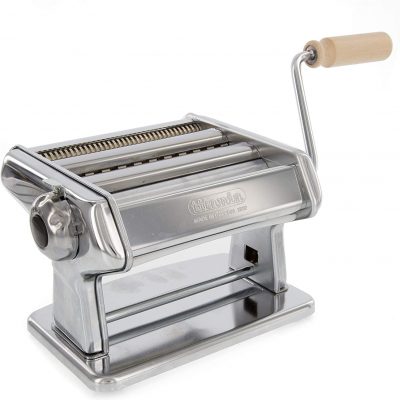Project Report For Pasta Maker
Introduction
Project Report For Pasta Maker is as Follows.
A medium-sized kitchen gadget known as a pasta maker or pasta machine is used to manufacture fresh pasta such as ravioli, lasagne, fettuccine, and tagliatelle by rolling and cutting egg noodles or other types of dough. To make laminated pasta, a pasta machine is utilised.
They are normally made up of two stainless-steel rollers with adjustable settings that are used to knead and stretch the pasta dough. Pasta machines are frequently sold with a replaceable cutter that produces pasta shapes such as spaghetti and linguini. Most kitchen stores and/or Italian delis sell pasta machines. Basic pasta machines are reasonably priced. There are also numerous attachments available, ranging from various-shaped cutters to attachable motors.
Pasta makers make the process of making pasta much easier and more convenient. They are designed to knead the dough, roll it out, and cut it into various shapes and sizes. These machines can save you a lot of time and effort, as the entire process of making pasta can be done in one machine, with very little manual labor required.
There are several types of pasta makers available in India, including manual and electric models. Manual pasta makers are usually operated by hand, while electric pasta makers have a motor that drives the machine.
Manual pasta makers are ideal for people who enjoy the process of making pasta, as they provide more control over the dough and the shapes it is cut into. They are also more affordable than electric pasta makers, making them a great option for those on a budget.
Electric pasta makers are more convenient and faster than manual models, and they often come with multiple attachments for cutting different shapes of pasta. They are a great option for those who want to make pasta quickly and easily, without having to put in a lot of effort.

Benefits Of Pasta Maker
- Fresh and flavorful pasta :- Homemade pasta tastes better than store-bought pasta because it is fresher and has no preservatives or additives. With a pasta maker, you can make your own pasta from scratch using high-quality ingredients.
- Time-saving :- A pasta maker can help you save time in the kitchen by automating the pasta-making process. It takes just a few minutes to make a batch of pasta using a pasta maker.
- Versatile :- A pasta maker can be used to make a wide variety of pasta dishes, from simple spaghetti to more complex dishes like lasagna or ravioli.
- Cost-effective :- Making your own pasta at home is often less expensive than buying pre-packaged pasta from the grocery store.
Get Completely Custom Bankable Project Report
Market Potential Of Pasta Maker
The market for Pasta Maker is anticipated to expand at a CAGR of 5.6%. By 2033, the market is expected to have grown from US$ 2,100 million to US$ 3621.22 million.
The worldwide market is divided into offline and online retailers. The offline sector is projected to hold a large proportion of the market since people can touch and comprehend the goods in person at such a store. The global market is divided into three categories: residential, commercial, and industrial.
The home sector is expected to account for a sizable proportion of the global market due to the widespread usage of smart kitchen equipment by domestic customers worldwide for their regular cooking and baking activities. Furthermore, the expanding urbanisation rate, as well as the need for smart housing facilities, are projected to accelerate future segmental growth.
Pasta is connected with various health benefits, which are backed by a high concentration of minerals and vitamins, and its demand is predicted to increase over the forecast period. Pasta is predicted to expand in popularity in emerging markets such as China and India as a result of a big millennial population and the expansion of food service outlets.
People’s hectic schedules are likely to benefit the worldwide industry from an increase in demand for ready-to-eat goods. To meet the rising demand from health-conscious consumers, companies are intending to develop quinoa and whole wheat pasta.

